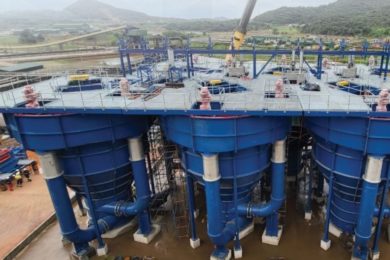Aiming to mitigate the risk of long term International Cyanide Management Institute non-compliance and possible detrimental environmental impact of discharging high weak acid dissociable (WAD) cyanide levels in its CTSF tailings dam, Barrick Gold Corp-operated Kibali Goldmines (KGM) in DRC several years ago began evaluating the possibility of using AZMET Technology & Projects’ Cyanide Removal Process (CRP) technology. KGM is owned by Barrick (45%), AngloGold Ashanti (45%) and SOKIMO (10%).
The current CRP project builds on earlier cooperation which included a 2015 SMPP contract awarded to AZMET for the Kibali operation, to implement the Desliming Cyclone Circuit which was part of an optimisation project to improve the overall pumpcell plant recovery.
For the CRP tech, initially, pilot plant Phase 1 and Phase 2 trials were performed on the pumpcell tails (PCT) and CIL tails slurry during both campaigns (full sulphide and oxide-sulphide), in which very high WAD cyanide levels were observed in the CIL tails slurry. Results showed that WAD CN levels below 20 ppm were achieved on the CIL tails with an expected benefit due to additional gold and cyanide recovery.
Analysis and review then took place for a potential $26.75 million, 4.8 Mt/y plant, to allow treatment of the full oxide-sulphide CIL tails stream with an OPEX cost estimated at $0.43/t. The AZMET-CRP plant is now nearing completion and is set for commissioning in Q2 2023.
Based on the Kibali LOM, the onsite testwork, trade-off studies and financial analysis showed that the AZ-CRP is more effective and economic when compared to other detox methods such as the Peroxide Detox & INCO process. Another benefit of the AZMET CRP plant is the additional gold and cyanide recovery leading to an after-tax payback period of less than four years.
AZMET says the process uses well known activated carbon technology to extract free cyanide radicals, as well as metal cyanide complexes from gold tailings. It says: “OPEX and environmental constraints related to cyanide are two major issues facing the gold industry today. The AZ-CRP will decrease pressure on both constraints. The AZ-CRP is especially well suited for the extraction of copper cyanide from both solution or pulp streams. The AZ-CRP can produce partial recycled cyanide at a fraction of the price of new cyanide.”
It adds: “When the cost of cyanide destruction is included, which is mandatory by the ICMI, the cost reduction of buying and destroying cyanide in the tails stream, becomes extremely attractive in the current competitive gold market. In addition, the AZ-CRP technology provides the benefit of secondary extraction of gold and other precious metals to ensure maximum yield within the client’s process operation.”
The AZ-CRP allows additional recovery of gold and other precious metals in the leach tails as well as recovery of valuable base metal by-products in the eluate. It removes cyanide in final tails for partial reuse in the leach circuit. Cyanide tailings discharge are within the limits as prescribed by the International Cyanide Code (ICMI). It uses proven gold processing technologies and reagents currently already used in gold processing facilities. The leach tails do not require additional cyanide destruction after the AZ-CRP.
Kibali continues to maintain its Tier One production profile, with 750,000 oz produced in 2022. It also continues to lead the way on sustainable mining practices with a feasibility study for a 17 MW solar farm completed and construction to be finalised in 2025. The project is expected to increase renewable energy sourcing from ~81% to ~93%. A step up in open pit mining has seen an improvement in open pit tonnes year on year, delivering 5.67 Mt of ore material mined in 2022, securing stockpiles to support a strong start to 2023. For the underground mine, a planned rock winder upgrade was successfully completed in Q4 2022.










